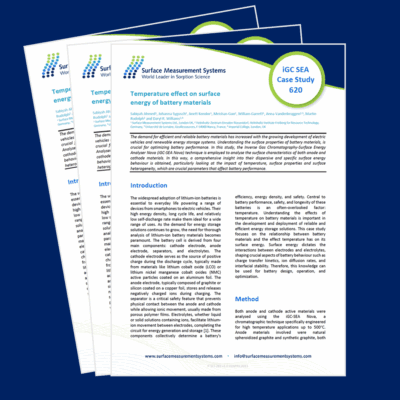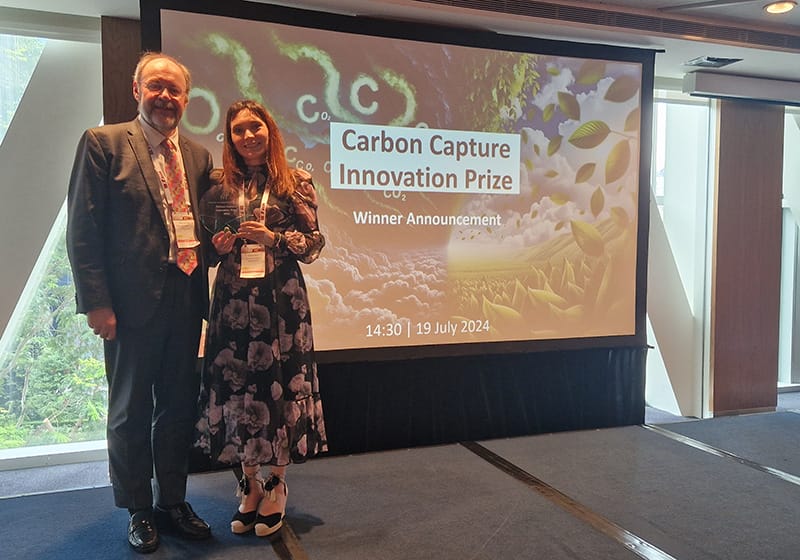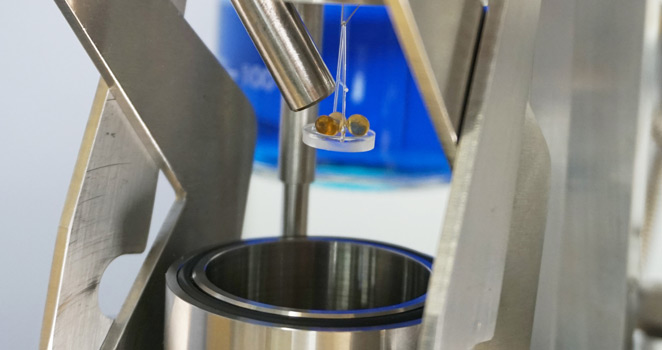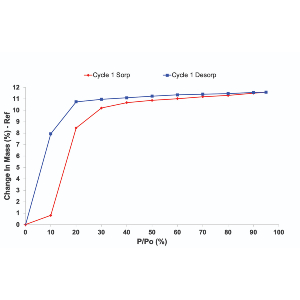
2024: New starters
for the SMS Team
The team at Surface Measurement Systems continues to expand, with every office seeing new members join us for the exciting times ahead!
Below is a quick review of who has joined us in the last year.

New Team members

Exploring Zeolite 13X for Realistic Direct Air Capture:
A New Application Note in Sorbent Evaluation


Sorption Bulletin
Best of 2024
We are happy to offer you this Sorption Bulletin, providing an overview of some of our most exciting recent publications, peer-reviewed papers, and interesting articles in the field of sorption science.
Discover the latest insights and technological advances in a range of applications.

SMS Scientific Notes
Application Note 112: Influence of humidity and temperature on the drying kinetics, phase composition and morphology of gypsum
Download a copy
Case Study 620: Temperature effect on surface energy of battery materials
Download a copy
Application Note 70: Investigating Uniformity of Dry Powder Inhalation Formulations using Vapour Sorption Techniques
Download a copy
Application Note 109: Studying Moisture Induced Transformations and Degradation of Pharmaceutical Ingredients Using Raman Spectroscopy Combined with Dynamic Vapor Sorption
Download a copy
Application Note 110: Analyzing Multicomponent Permeation Through Barrier Membranes Using the Membrane Permeation Analyzer (MPA Horizon)
Download a copy
Application Note 111: Realistically evaluating the capabilities of Zeolite 13X as a sorbent for Direct Air Capture in different scales
Download a copy
Additional Reading
Carbon Capture Storage Review 2024
Download a copy
Article: Innovative Approaches to Analysing Moisture Interactions in Pharmaceutical Materials with Dynamic Vapor Sorption (DVS)
Read here
Publications
Scientific Paper: MOF-based sensors for the detection of airborne α-pinene, RSC Appl. Interfaces 2024, 10.1039.D4LF00027
Read here
Book: Chapter 3: The Dynamic View: Multiscale Characterisation Techniques for Flexible Frameworks
The Dynamic View: Multiscale Characterisation Techniques for Flexible Frameworks | Flexible Metal–Organic Frameworks Structural Design, Synthesis and Properties
Books Gateway | Royal Society of Chemistry (rsc.org)

Across the World,
SMS’ers Celebrated the Festivities in Style!
It’s been a busy end to the year for Surface Measurement Systems, with a huge push in instrument sales, Production sending products flying out the door, and Sales still hitting the road to drum up those last bits of busy!
Somehow, we’ve still found time across the world to celebrate our festive seasons as a team! From Diwali in Hyderabad to Christmas in London, the Global SMS Team celebrated the festivities in style!

SMS India & PCL Celebrate Diwali
| The SMS India & PCL Team held a special event to celebrate the five-day Diwali Festival. Marking the Hindu New Year, Diwali symbolizing new beginnings and the triumph of good over evil. Also known as the Festival of Lights, Diwali is celebrated through the sharing of meals and sweets, decorating with oil lamps called “diyas”, making colorful patterns on the floor called rangoli (see below), and setting off fireworks. Hopefully, this last activity was done outside of the office.
Happy Diwali to all our Hindu colleagues in Hyderabad, and around the world! |
SMS UK Toast Christmas at Pub Party
| The team from Surface Measurement Systems London got in the Festive spirit with a company lunch at the Defector’s Weld Pub in Shepherd’s Bush. Following a hearty meal, company Founder & MD, assumed the sacred duty of handing out Secret Santa gifts to all members of staff. |

SMSNA Saving the Best for Last
Not to be outdone, our colleagues at SMSNA are saving their best for last, having their Christmas Staff Meal later this week! We wish them a happy Season’s Greetings, and hope they have a great day celebrating the festive season!

Carbon Capture
Sorption Science Pack
Download Free Now
Surface Measurement Systems have been pioneering sorption-based solutions Carbon Capture, developing groundbreaking new instruments that enable analysis and insights never possible before.
Please download this free pack of recent scientific publications on Carbon Capture Applications of sorption science, including recent case studies and scientific overviews. If you have any questions about the topics explored, please do stop by our stand at AiCHE 2024.
Expanding the Senior Leadership Team:
Driving the Future of
Surface Measurement Systems
Surface Measurement Systems Holding LLC and its subsidiaries are entering an exciting new chapter, marked by growth, innovation, and an ambitious vision for the future. To support this next phase, we have expanded our Senior Leadership Team, ensuring we have the expertise and leadership needed to meet our goals.
This expansion includes elevating talented team members and welcoming new leaders, bringing fresh perspectives and expertise. With this enhanced team in place, SMS is better equipped than ever to drive innovation, seize emerging business opportunities, and continue improving our solutions to meet the evolving needs of our customers.
The future of Surface Measurement Systems is bright, and this leadership expansion reflects our commitment to staying at the forefront of sorption innovation, delivering exceptional value and results.

Senior Leadership Team

Europe & US Symposiums bring leading sorption scientist together
2024 saw a grand return for the live editions of the Sorption Symposium Series. With the 202 Pandemic scuppering plans for a live scientific event in 2020, Surface Measurement Systems were thrilled to be able to bring the event back to the face-to-face format, enabling a shared learning and networking experience for sorption scientists from around the world.
Eager to offer an in-person return to our users and peers around the world, the Sorption Symposium saw two live events held this year. The first, taking place in May, was held at the New Jersey Institute of Technology, while the second returned to the venue we had to cancel in 2020, University of Vienna, for our European symposium in September.

Sorption Symposium North America 2024 (7 – 9 May)
Gathers Leading Sorption Experts in New Jersey
Gathers Leading Sorption Experts in New Jersey
| The Sorption Symposium North America 2024, organized by Surface Measurement Systems, recently concluded with great success, showcasing the latest advancements in sorption science. Held in Allentown, PA, the event attracted over 60 attendees from various industries, including pharmaceuticals, environmental sciences, and material engineering. It offered a rich program featuring renowned speakers such as Dr. Maria Krisch from FreeThink Technologies and Dr. Neeraj Borker from 3M. Their presentations, alongside other experts, covered critical topics in sorption behavior, moisture analysis, and its applications across diverse fields.
A highlight of the event was the strong participation in the hands-on training sessions, where attendees received practical insights and guidance from an expert panel. The training provided an interactive platform for participants to deepen their understanding of dynamic vapor sorption (DVS) technology and its role in enhancing material performance, stability, and formulation development. This engaging format fostered an environment of collaboration and learning, elevating the educational value of the symposium. The symposium also created ample opportunities for networking, particularly during the on-site Networking Party. Attendees had the chance to connect with peers, exchange ideas, and explore potential collaborations, further strengthening the event’s impact. Overall, the Sorption Symposium North America 2024 was a resounding success, bringing together a diverse group of professionals to share knowledge, engage in hands-on experiences, and build relationships within the sorption science community. |
|
 |
 |
 |
 |
University of Vienna Plays Host to
Sorption Symposium Europe 2024 (18 – 20th Sept)
Sorption Symposium Europe 2024 (18 – 20th Sept)
|
The Sorption Symposium Europe 2024, hosted by Surface Measurement Systems, was a resounding success, gathering over 70 attendees at the University of Vienna from September 18-20. This premier event brought together leading minds from academia and industry to explore cutting-edge advancements in sorption science, particularly focusing on Dynamic Vapor Sorption (DVS) and Inverse Gas Chromatography (iGC), and recent developments in Carbon Capture Sorption Analysis capabilities. The symposium featured a stellar lineup of speakers, including Dr. Daniel Burnett and Dr. Anett Kondor from Surface Measurement Systems, along with global experts like Dr. Neeraj Borker (3M), Prof. Peter Budd (UManchester), Dr. Sam Zelinka (U.S. Forest Service), and many more. These presentations covered a broad spectrum of applications in pharmaceuticals, carbon capture, and material science, offering a comprehensive look at current research and future potential. Day three saw strong participation in hands-on workshops, where attendees received in-depth training on advanced sorption instruments, gaining valuable skills from global experts. In addition to the academic content, attendees enjoyed vibrant networking events, which included a wine and beer tasting, a traditional Austrian meal, and a unique ‘Hidden Vienna’ tour. These activities allowed participants to form lasting professional relationships in a relaxed atmosphere, enhancing the collaborative spirit of the symposium. |
|
 |
 |
 |
 |

2024: New starters
for the SMS Team
The team at Surface Measurement Systems continues to expand, with every office seeing new members join us for the exciting times ahead!
Below is a quick review of who has joined us in the last year.

New Team members

Heriot Watt University Team Wins Prestigious Carbon Capture Innovation Prize
Singapore, July 19, 2024 — In a significant stride towards addressing climate change, the Carbon Capture Innovation Prize has recognized pioneering efforts in the emerging field of carbon capture. This prestigious competition, organized in conjunction with the MOF2024 conference, underscores the critical importance of developing sustainable materials solutions to combat global warming.


The Competition: Accelerating Climate Solutions
The Carbon Capture Innovation Prize, organized by Surface Measurement Systems (SMS), was a groundbreaking contest aimed at accelerating the development of innovative carbon capture technologies. Held alongside the MOF2024 conference in Singapore in July, the competition focused on the innovative use of a state-of-the-art scientific instrument designed to measure the capture of carbon dioxide in adsorbent materials. The challenge invited startups, SMEs, and academic institutions to present their cutting-edge research on both direct air capture and flue gas capture technologies.
A Reward for Innovation
The winner of this esteemed contest receives a DVS Carbon instrument, valued at over $150,000, provided free of charge to their institution. The DVS Carbon is a pioneering sorption analyzer designed for advanced carbon capture, utilization, and storage (CCUS) applications. Equipped with Surface Measurement Systems’ patented Ultrabalance technology, the DVS Carbon enables real-time mass change measurements during sorption and desorption processes, facilitating the assessment of complex carbon capture conditions across various materials. This powerful tool, with its high-precision control of temperature and humidity over a broad range of CO₂ concentrations, will enable the winning team to advance their research, significantly contributing to the global effort to reduce carbon emissions and fight global warming.
“We launched this competition to recognize and reward outstanding research in carbon capture materials. By providing advanced tools and fostering collaboration, we aim to accelerate breakthroughs that are vital for mitigating climate change.”
– Prof. Daryl Williams, MD & Founder, Surface Measurement Systems
Rigorous Evaluation and Submissions
| The competition attracted over 90 proposals from researchers worldwide. Each submission underwent rigorous evaluation by a panel of expert judges, who assessed the proposals based on the following criteria:
1. Relevance to Carbon Capture: Alignment with the overarching goals of developing efficient CO2 capture technologies. 2. Innovation: Novelty and originality of the research approach. 3. Scientific Rigor: Validity and robustness of the proposed methodology. 4. Impact Potential: Potential contributions to advancing carbon capture research. 5. Clarity and Feasibility: Coherence and realism of the research plan. 6. Potential for Collaboration: Openness to collaboration and knowledge exchange within the scientific community. The judges sought proposals that addressed the challenges and opportunities in carbon capture, demonstrated innovative ideas, and exhibited sound scientific methodologies. The potential impact of the research on advancing the field, as well as the clarity and feasibility of the proposed plans, were crucial evaluation factors. Proposals that highlighted a pathway to new fundamental understanding, novel materials, or solutions to process scale-up challenges were particularly valued. |

Finalists and the Ultimate Winner
After a meticulous review, the judges selected six finalists:
- Arizona State University (USA)
- Avnos (USA)
- CICECO – Aveiro Institute of Materials (Portugal)
- Georgia Institute of Technology (USA)
- Heriot-Watt University (UK)
- Tsinghua University (China)
Finally, in an award ceremony during the closing sessions of MOF2024, Prof Susana Garcia and her team from Heriot-Watt University in the UK were announced as the winners of the Carbon Capture Innovation Prize. Prof Garcia expressed her gratitude and excitement:
“I am extremely honoured to receive the prestigious SMS 2024 Carbon Capture Innovation Prize, which recognises our efforts and pioneering work on accelerating carbon capture technologies. We aim to accelerate the transition to a Net-Zero carbon economy by developing an open-access experimental protocol, which accurately characterises the thermodynamics, in-depth mass-transfer mechanisms and CO2-H2O adsorption kinetics on Direct Air Capture (DAC) sorbent materials using the unique features of the DVS Carbon. It will address knowledge gaps in adsorption kinetic studies for solid sorbents under realistic conditions, providing essential, rigorously produced data. This data will aid in assessing and designing sorbents for optimal DAC process performance and standardising measurement protocols for benchmarking within the carbon capture community.”– Prof Susana Garcia, Heriot-Watt University

A Brighter Future for Carbon Capture
Looking ahead, Surface Measurement Systems remains committed to supporting Prof. Garcia and her team in their research endeavors. Dr. Williams expressed his enthusiasm for the partnership, stating, “We eagerly anticipate the advancements that Prof. Garcia and her team will achieve with the DVS Carbon instrument. Their work exemplifies the innovative spirit and scientific excellence that this competition aims to promote. We look forward to sharing their progress and its impact on a more carbon-efficient future.”
For more information on the Carbon Capture Innovation Prize and updates on the winner’s research, check back soon at www.sorptionhub.com. You can find out more about the DVS Carbon instrument here.

Sorption Overview Series #6
Conclusions
Thank you for joining us for the final entry in our ‘Sorption Overview’ blog series. Over the past weeks we’ve explored the various experimental techniques for measuring gas and vapor sorption: gravimetry, volumetry and chromatography. These techniques play a crucial role in determining fundamental material properties and assessing material performance across diverse applications.
As well as summarising the points made in this series below, with this final blog we are happy to release the full combined Sorption Overview note; a useful scientific resource combining all the information covered in this blog series. A great resources for grounding students in sorption knowledge, or onboarding new lab staff, you can download the note free below.

| Gravimetric | Volumetric | Chromatographic | |
| Short Description | A microbalance directly measures the change in weight as the gas/vapor is adsorbed in the material. | The sample is placed in an enclosed cell, where successive doses of gas are introduced. Pressure in the cell is monitored. | A stream of known molar flowrate is passed through a column / packed bed. Concentration at the outlet is monitored and a mass balance is calculated. |
| Primary Measured Parameters | Sample weight change. Temperature & pressure/concentration. | Pressure decay in a closed cell of known volume. Temperature & pressure/concentration. | Flowrate in/out of a packed bed. Temperature & pressure/concentration before and after the bed. |
| Sample Minimum Amount | from 1-10 mg | from ~50-100 mg | From 50-100 mg |
| Sample Maximum Amount | 1 – 100 g | 1-5 g | 100 g – few kg |
| Pros | Highly accurate and flexible with samples and measurement conditions. Smallest sample amounts needed. Direct measurement of uptake. Can operate in both dynamic and static mode. Provides sorption kinetics by default. Can easily perform both isotherm (pressure scan) and isobar (temperature scan) experiments. Sample drying/activation is followed directly and quantified. | Low complexity, simple to implement and to parallelize. Straightforward to obtain wide temperature and pressure ranges. Easier to hyphenate as the sample can be located away from the instrument. | Provides true multicomponent sorption data from mixtures. Pulse retention time can be used to determine isotherms and surface parameters. IGC method can measure minute surface areas. Can provide information into process relevant parameters – mass and heat transfer. |
| Cons | Complex engineering required– best with bespoke instrumentation. Cannot measure true multicomponent sorption, though can measure total amount adsorbed from a mixture. Buoyancy correction may be difficult at high pressures. | Indirect measurement of uptake – must rely on equations of state. Cannot use dynamic or carrier probe introduction. Difficult to record isobars and sorption kinetics. Cannot measure multicomponent sorption. Incremental compounding error for each dose. Pressure gradients between sample and reference can be significant at low partial pressures. | Indirect measurement of uptake – must rely on equations of state. Complex to set up and correctly analyze data – best with bespoke instrumentation. Often not suitable for fine powders due to pressure drop. |
| Method Applicable | Static & dynamic introduction Pure & carrier | Static only Pure & carrier | Dynamic only Pure & carrier |

Find out more about advanced sorption solutions below
You can find out more about the advanced sorption techniqued employed by Surface Measurement Systems using the link below, as well as survey our range of world-leading lab solutions.
Don’t hesitate to contact us if you have any queries about how our instruments can solve your material research problems.





































